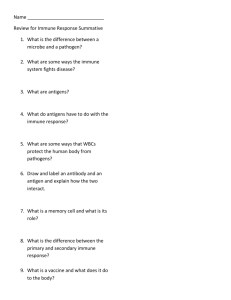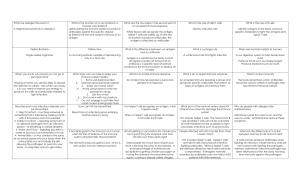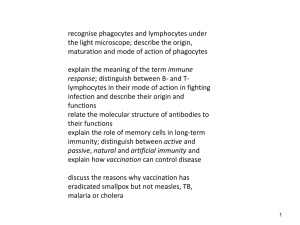Disease as a Failure of Homeostasis
advertisement
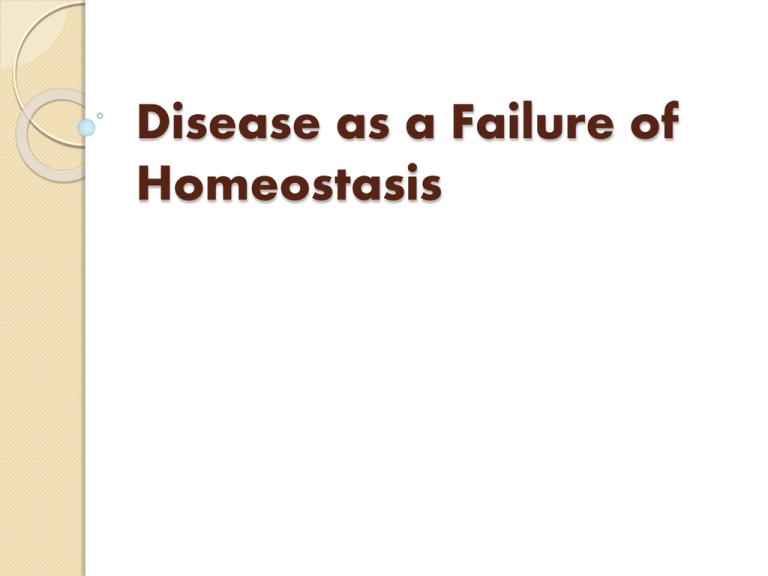
Disease as a Failure of Homeostasis Causes of Disease Inherited Diseases – GENETIC Down’s Syndrome Cystic Fibrosis Sickle Cell Anemia Exposure to Toxins – POISONS Lead Poisoning Radiation Poisoning Poor NutritionScurvy (Lack of Vitamin C) Goiter (Low Iodine) Organ Malfunction – Heart Attack Stroke (Brain) Diabetes (Pancreas) HIGH RISK BEHAVIORSLung Cancer (Smoking) Skin Cancer (Tanning) AIDS (Drug Addiction/Sexual Activity) PATHOGENS – Organisms that interfere with NORMAL functions of the body; they disrupt homeostasis VIRUSES Small, non-living “particles” of genetic material that invade living cells Chicken Pox HIV Measles Influenza Virus injecting its DNA into a cell Bacterium (Bacteria is plural) Bacteria- Singlecelled organisms Strep Throat Syphilis Food Poisoning Bacilli bacteria being surrounded by White Blood Cells Fungus (Fungi is plural) Fungi can be unicellular (1 cell) or multicellular (Many cells) Ringworm Athlete’s Foot Ringworm is a skin infection caused by a fungus. Ringworm can affect skin on your body (tinea corporis), scalp (tinea capitis), groin area (tinea cruris, also called jock itch), or feet (tinea pedis, also called athlete's foot). Often, there are several patches of ringworm on your skin at once. Parasites – Single-celled or multicellular organisms that feed off of living things causing them harm Malaria (Caused by a protist called Plasmodium) Leeches Tapeworms Heartworms Malaria is a mosquito-borne infectious disease of humans and other animals caused by protists (a type of microorganism) of the genus Plasmodium. It begins with a bite from an infected female mosquito, which introduces the protists via its saliva into the circulatory system, and ultimately to the liver where they mature and reproduce. CANCER- Group of diseases CANCER is caused by genetic changes that can occur within the cells of a tissue or organ resulting in uncontrolled cell growth LIVER CANCER on the right LUNG CANCER on the right The Immune System…. Humans have many ways to protect themselves from danger and disease….. * Our SENSES (eyes, ears, sense of smell) can help detect danger * We can release HORMONES (Adrenaline) to help our MUSCLES respond to danger (FIGHT OR FLIGHT) SKIN BODY FLUIDS * Unbroken SKIN keeps out foreign organisms that could be HARMFUL Fluids in the body such as * TEARS * SALIVA * OTHER BODY SECRETIONS, like Sweat, trap and destroy invaders * The skin acts as a barrier, blocking pathogens much like a wall around a Castle protects against invaders. The NERVOUS system provides rapid coordination of our body to danger. * Senses (Detect Danger) * Nerves in Muscles (Respond to Danger) * Signals to Endocrine Glands (Secrete Hormones) THE HUMAN BODY NEEDS AN EFFECTIVE WAY TO…. COMBAT or FIGHT OFF invaders or body cells that malfunction. The IMMUNE SYSTEM is the body’s primary defense against DISEASE-CAUSING PATHOGENS. Foreign substances that threaten HOMEOSTASIS can usually be identified by molecules on their outer surfaces. These molecules are called ANTIGENS, and they trigger (start) a response from the Immune System. Antigen-Antibody Diagram The body will make ANTIBODIES to fight off the ANTIGENS. The antibodies are SPECIFIC to the SHAPE of the antigen and will FIT in to deactivate the antigen. White Blood Cells can ENGULF PATHOGENS WBC’s SURROUND the bacteria and then “eat” it by releasing digestive enzymes which kill the bacteria. White Blood Cells can MAKE ANTIBODIES TO DESTROY ANTIGENS The WBC is making ANTIBODIES that can attack the invader or mark them for KILLING How WBC’s Fight Pathogens Some specialized WHITE BLOOD CELLS will remain in the body long after the pathogen is gone. These “Memory” cells will divide QUICKLY and produce more antibodies if they come in contact with that pathogen again. ANTIBODIES are effective against microbes (microscopic organisms) that appear YEARS later. Vaccinations Scientists have discovered that weakened MICROBES can stimulate (start) the Immune System to REACT (respond). Vaccines are made by using WEAKENED, Killed (dead), or Parts of MICROBES. When vaccines are injected into the BODY, the Immune System responds just as if it were invaded by a LIVE pathogen and will produce ANTIBODIES. After a vaccination, the Immune System…. REMEMBERS the specific pathogen by leaving behind special WHITE BLOOD CELLS that will protect the body for years! Making a Vaccine • • • • • Obtain the PATHOGEN Treat pathogen to KILL or WEAKEN it Inject the pathogen (VACCINE) into the organism The body responds by making ANTIBODIES and having the WBC’s ATTACK the invader Some WBC’s SPECIFIC for this pathogen remain in the body for a long time to continue PROTECTION from future attacks. DAMAGE/PROBLEMS ASSOCIATED WITH THE IMMUNE RESPONSE The immune system may weaken with AGE or other factors like STRESS, fatigue. This can make us more VULNERABLE to disease. Some viral diseases like AIDS result from an attack on the IMMUNE system. The damage leaves the person UNABLE to deal with infections and CANCEROUS cells. A WEAKENED immune system is one reason people with AIDS die of INFECTIONS that a healthy person could fight off. ALLERGIES An ALLERGY is a rapid immune response to substances that are usually harmless. Certain FOODS, pollen, and chemicals from INSECT bites are examples of things that can cause an allergic reaction. In an allergy, the body releases chemicals called HISTAMINES which can lead to a RUNNY nose, SNEEZING, rashes, and SWELLING. People with allergies often use… ANTI-HISTAMINES to reduce their symptoms. AUTOIMMUNE DISEASE Sometimes the immune system malfunctions and fails to recognize “SELF” molecules and attacks the body’s own cells. Lupus Rheumatoid Arthritis Juvenile Onset Diabetes ORGAN TRANSPLANTS Since a transplanted organ comes from ANOTHER person, the immune system recognizes it as an INVADER and may start to attack the new organ. To avoid REJECTION, transplant patients receive special drugs to suppress their IMMUNE system. This may leave the patient ILL from a pathogen that would normally be no threat.



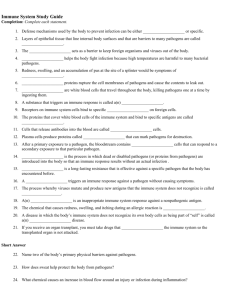
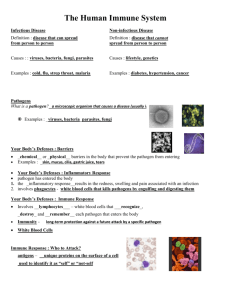
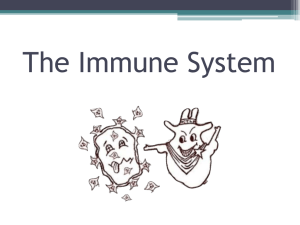
![Immune Sys Quiz[1] - kyoussef-mci](http://s3.studylib.net/store/data/006621981_1-02033c62cab9330a6e1312a8f53a74c4-300x300.png)
